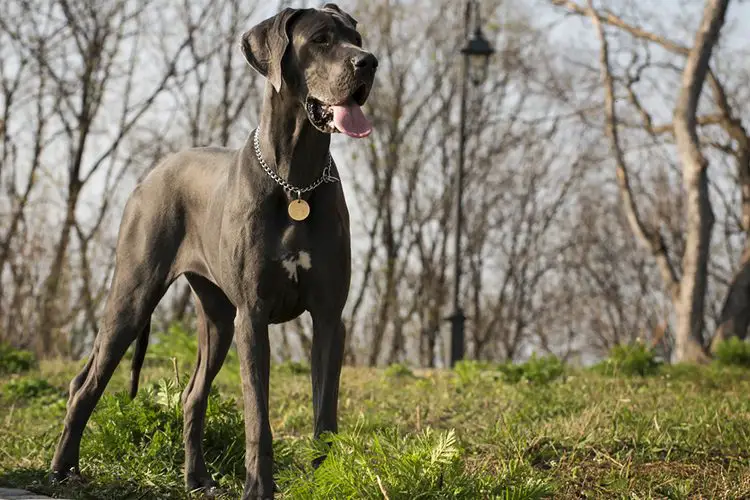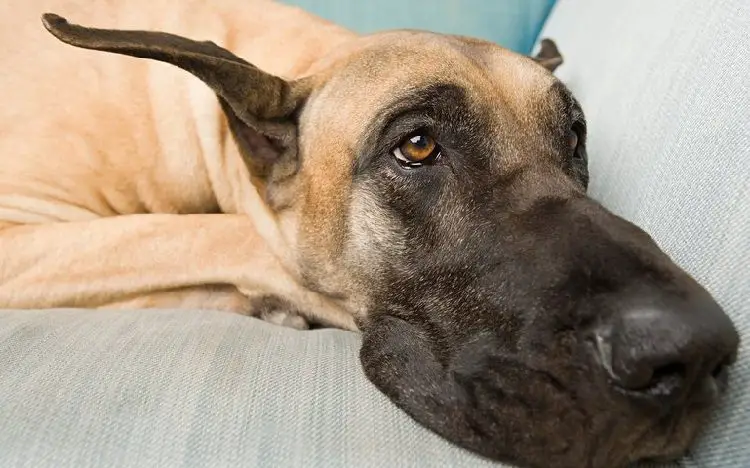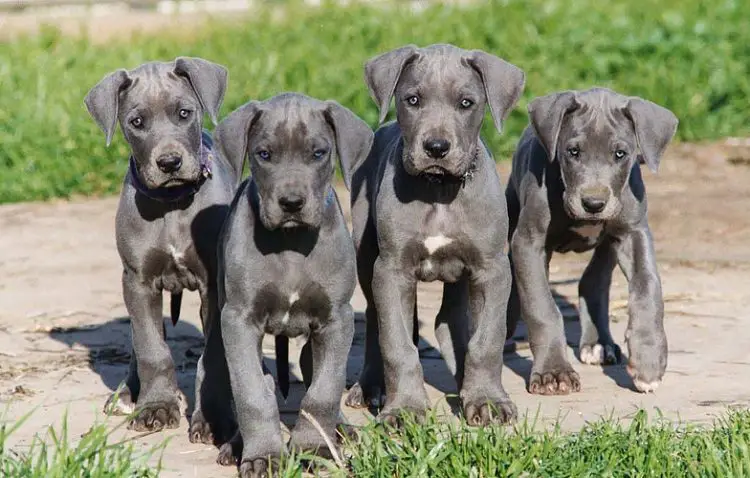Last Updated: 2 years ago
Great Danes are majestic dog breed with a friendly and affectionate personality but there are some definite challenges to owning one so if you have been looking into getting a Great Dane, make sure you know all the key info so you are fully prepared and know what to expect and what to watch out for.
Physical Characteristics

Great Danes are massive. On average, they grow to a height of about 2 ft. 4 in. and they weigh anywhere from 100 to 200 pounds. They are huge. They were originally bred to hunt wild boars so they had to be large, powerful, and fast in order to handle the job.
They have floppy ears that used to be cropped to prevent injury (from violent boars) but today, it is unnecessary and only done for appearance but we find those floppy ears adorable so we don’t recommend cropping.
There are 3 main variations on coat colors: gold/cream with black around the eyes, brow, and ears; solid black with white markings on the chest and toes; solid steel blue (sometimes with white markings on the chest and toes). Patterns can vary widely with stripes, spots, and other variations.
Personality and Temperament

Originally, Great Danes were not a friendly breed. In order to hunt wild boar, they needed to be as aggressive and ferocious as their prey.
But by the 1800s, people were more interested in keeping them as pets than using them for hunting so they began to breed gentler, more affectionate Great Danes.
The transition was a success. Today, Great Danes are some of the sweetest and most loving dogs you’ll ever meet.
They get along very well with people, including children and they are extremely loyal. Any ferocity that remains from their boar hunting days has been transformed into being fiercely protective of their family. Take a look at our gallery of Great Danes.
Common Health Issues

Great Danes are a comparatively healthy breed but as with any purebred dog, there are some health risks to be aware of. For Great Danes, you’ll want to be on the lookout for the following:
Hip Dysplasia
this is a genetic condition that many breeds are prone to.
The bone of the thigh does not join properly with the hip joint and this causes painful walking and general discomfort. It usually appears early on in life if appears at all so be alert to signs of difficult walking, limping, difficulty getting up or sitting/laying down, or reluctance to play or be active.
It can’t be cured but it can be managed with diet and medication.
Gastric Torsion
this condition affects a lot of large breeds. When a dog eats too much in one sitting or drinks too much water at once, the stomach distends and fills with air or gas.
Then, it can get twisted, trapping that gas in its stomach. It can be life-threatening so check for symptoms such as a bloated abdomen, excess salivation, weakness, and attempting to throw up without anything coming up.
Bone Cancer
large breeds like the Great Dane are at higher risk for bone cancer. Early detection is key so we recommend regular checkups.
The cancer is usually very aggressive but with aggressive treatment and early detection, they can usually live one or two more years after diagnosis.
Unfortunately, there’s not much you can do to prevent bone cancer or hip dysplasia. The best you can do is be alert and proactive about diagnosing these early so that you can start treatments.
Gastric torsion, on the other hand, can be prevented by controlling your Great Dane’s portions. There will be more on that in the next section.
Basic Care Instructions

Caring for a Great Dane requires commitment. You need to be able to feed it multiple meals a day, provide it with 60 to 90 minutes of exercise per day, and make sure it has enough room in your home so that it doesn’t knock into everything.
On the bright side, if you’ve been trying to get more exercise yourself, a Great Dane is an excellent motivator. But wait to take him on your runs until he is at least 18 months old (when his bones are fully formed).
Their diet should be relatively low in protein as they can grow too rapidly and develop growing problems with too much protein (which promotes muscle and bone growth). It’s also important to practice portion control with your Great Dane.
The amount they should eat per day varies. Puppies should eat 4 to 8 cups a day while dogs from 8 months to a year should get 6 to 10 cups per day. Adolescents and adults should get between 8 and 15 cups (more for males, less for females).
This should not be given all at once as they may scarf it down to quickly, potentially causing gastric torsion. Split this up over at least 2 meals (but 3 or 4 would be ideal).
It’s also worth noting that if you intend to keep your dog out in the yard, you’ll need a 6 foot tall fence to prevent him from getting out. And he will almost certainly tear apart any garden or landscaping you try to maintain. You also need to invest in a durable dog muzzle and heavy duty dog crate.
Final Word
Great Danes are a somewhat high maintenance breed in terms of needing to pay extra attention to feeding and making sure they get lots of exercise (consider getting a quality dog treadmill). They also eat a lot so it can be expensive.
But, if you are willing to deal with these factors, owning a Great Dane will be an extremely rewarding experience. You’ll have a loving and loyal companion at your side that will defend your family with everything it has.



